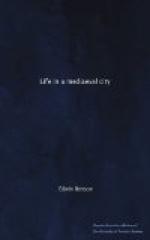The religious orders were of two kinds, viz. monks (and nuns) who lived in seclusion in monasteries, abbeys, or convents, and friars, who lived under a rule but came out into the world to preach and work. Both kinds took the vows of chastity, poverty, and obedience to the rule (e.g., Cistercian or Benedictine, Franciscan or Dominican). Some, but not all, monks and friars were priests. There were four well-known orders of mendicant friars, viz. Franciscan (Grey friars, friars minor), Dominican (Black friars, friars preachers), Carmelite (White friars), Augustinian (Austin canons). Monks and friars wore sandals, and long, loose gowns with hoods or cowls which they could pull over their heads to serve as hats. The alternative titles of some of the orders of friars came from the colour of their friars’ gowns. The Carmelites used undyed cloth, which was white in comparison with the black of the Dominicans. The Benedictine monks of St. Mary’s Abbey wore black garments. Their heads were shaved on the crown, the technical term for which was the tonsure.
[Illustration: SEMI-CHOIR OF FRANCISCANS. From a Fifteenth-Century Manuscript.]
Monks spent their time in attending the frequent services in the monastery church, which they entered at the night and early morning services directly from the dormitories; in copying manuscripts, which occupied a large part of their day; in contemplation and in study; in manual work; in recreation. The cloister where work was carried on and the church were the essential buildings of the monastery. Monastic life centred in these two places. Its arrangements were dictated by the purpose of making a religious atmosphere pervade everything; thus a religious book was read at meals.
The luxury and laxity that obtained in monastic life were not confined to the fifteenth century. The Archbishop had frequent occasion in the fourteenth century to complain, for instance, of the use by monks and nuns of ornaments, and of clothes of finer material than the traditional rule permitted. He condemned the wearing of clothes cut to a worldly pattern. The religious had to be admonished from time to time not to admit strangers within the cloister, and to conform in all respects strictly to their rule.
During the century St. Mary’s Abbey contained about sixty monks, including the Abbot, the supreme head, and the Prior, who held the second highest office; besides, there was a very large number of lay-brethren, servants and officers, for in addition to the internal work at the abbey, there was the management of the abbey estates and business. Abbots and monks were always keen traders. Altogether the personnel of St. Mary’s might have numbered about two hundred.




